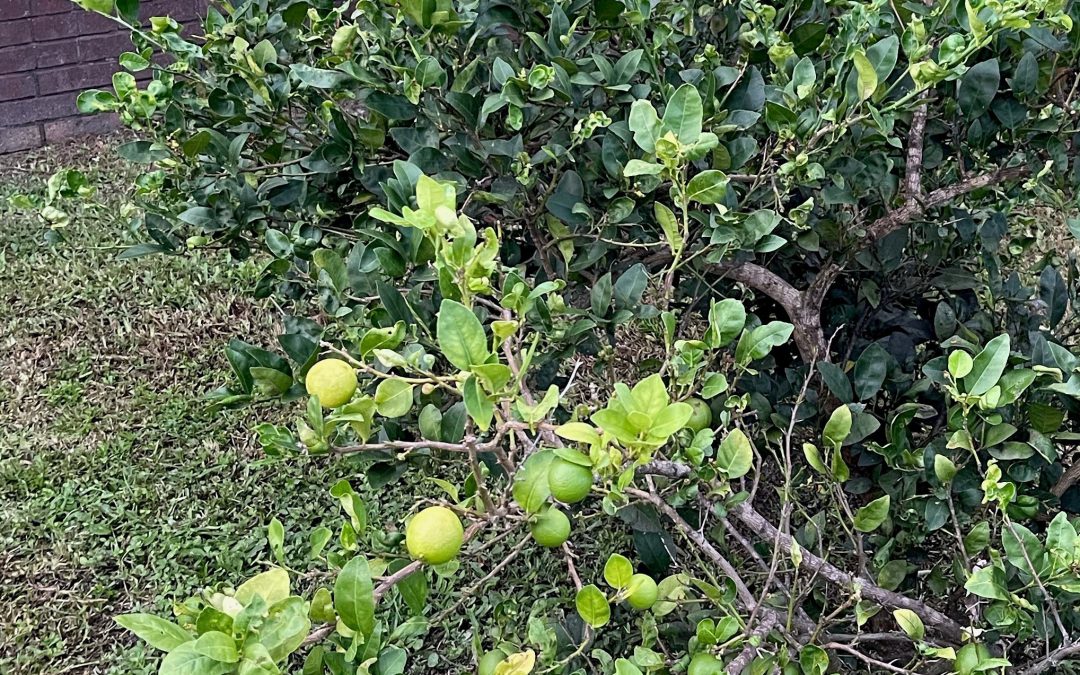
by Ray Bodrey | Sep 9, 2021
Growing Key Limes in the home landscape is not only a fun and unique addition, but is also delicious – any way you slice them.
The key lime, Citrus aurantifolia, originated in southeast Asia. Genetically speaking, the key lime is likely a tri-hybrid cross between the “odd ball fruits”, known as citron, pummelo and a microcitrus species, Citrus micrantha. There is little commercial key lime production nowadays in Florida, but the fruit remains a very popular landscape option.
The key lime is a small, bushy tree that makes harvest and pruning a breeze. Like most citrus, it’s self-pollinating. The key lime is also an ever-bearing fruit, so there is no real seasonal harvest. The tree could technically bloom any month of the year. There are very few varieties, as trees mostly come from true seed or air layering.
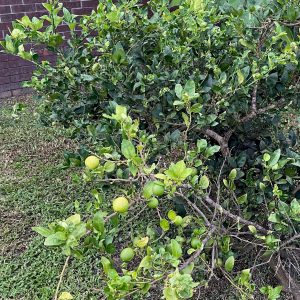
Key Lime fruit at various degrees of ripeness. Photo courtesy of Ray Bodrey, UF/IFAS Extension Gulf County.
Climate is an important factor when deciding to plant a key lime. They are sensitive to cold temperatures, especially below freezing. For the Panhandle, it’s wise to keep key lime trees as patio citrus. In other words, keep the trees in pots so that they can be moved indoors for protection during the winter months. In the ground, trees should be planted in an area where there is a significant wind block. Once a few years have passed and tree has become more mature and acclimated to the environment, they may be able to survive on their own, though it is recommended to cover the tree under sub-freezing temperatures. However, it is important to remember that sunlight is a catalyst for citrus fruit production, be sure to plant the tree in an area with full sun.
The usual suspects of citrus insect pests apply to the key lime also. Citrus leaf miner and mites are the most common culprits. Horticultural and insecticidal oils will certainly help to combat these threats. For planting, key lime is well adapted to a variety of soil conditions in Florida. Be sure to water newly planted trees every other day for the first week and then one to two times a week for the first couple of months. Water periodically after that, making sure the soil doesn’t stay completely dry for long periods. A 6-6-6 fertilizer works great for the key lime. Please follow the fertilizer schedule found in the UF/IFAS EDIS publication, “Citrus Culture in the Home Landscape” by Robert E. Rouse and Mongi Zekri: https://edis.ifas.ufl.edu/pdf/HS/HS132/HS132-11822781.pdf
A final interesting thing about the key lime is the ripening stages of the fruit. Because key limes are ever-bearers, blooms can develop at sometimes widely varying times. This causes an uneven development of fruit across the tree. Be sure to wait until the fruit turns begins to turn yellow before harvest. That’s when it’s mature to eat! Fruit can be stored for up to a week in the fridge or can be juiced and stored in the freezer for later use.
Please contact your local county Extension office for more information. Happy Gardening!
Information for this article can be found in the UF/IFAS EDIS publication, “Key Lime Growing in the Florida Home Landscape” by Jonathan H. Crane: https://edis.ifas.ufl.edu/publication/CH092
UF/IFAS Extension is an Equal Opportunity Institution.
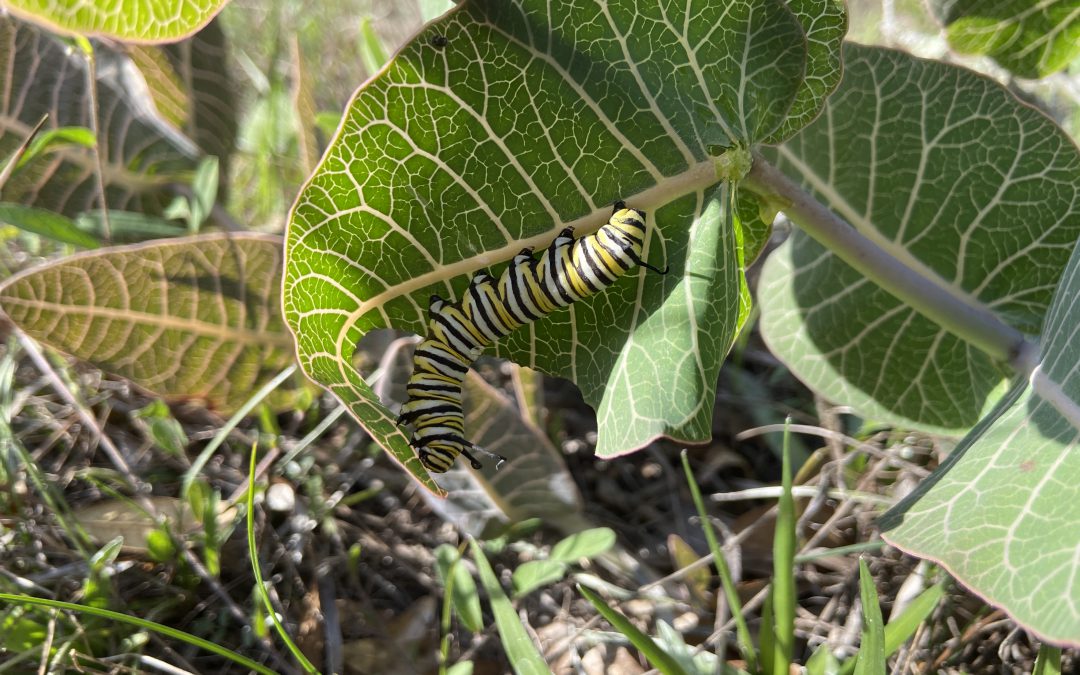
by Mary Salinas | Aug 20, 2021
On August 12, 2021, our panel answered questions on a wide variety of landscape topics. Maybe you are asking the same questions, so read on!
Ideas on choosing plants
What are some perennials that can be planted this late in the summer but will still bloom through the cooler months into fall?
Duranta erecta ‘Sapphire Showers’ or ‘Gold Mound’, firespike, Senna bicapsularis, shrimp plant, lion’s ear
Where can native plants be obtained?
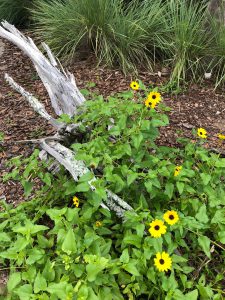
Dune sunflower, Helianthus debilis. Photo credit: Mary Salinas UF/IFAS Extension.
Gardening Solutions: Florida Native Plants – see link to FANN: https://gardeningsolutions.ifas.ufl.edu/plants/ornamentals/native-plants.html
What are some evergreen groundcover options for our area?
Mondo grass, Japanese plum yew, shore juniper, ajuga, ferns such as autumn fern.
What are some ideas for partial morning sun butterfly attracting tall flowers to plant now?
Milkweed, salt and pepper plant, swamp sunflower, dune sunflower, ironweed, porterweed, and salt bush.
I’m interested in moving away from a monoculture lawn. What are some suggestions for alternatives?
Perennial peanut, powderpuff mimosa, and frogfruit.
We are new to Florida and have questions about everything in our landscape.
Florida-Friendly-Landscaping TM Program and FFL Web Apps: https://ffl.ifas.ufl.edu/
https://ffl.ifas.ufl.edu/resources/apps/
UF IFAS Gardening Solutions: https://gardeningsolutions.ifas.ufl.edu/
What are some of the top trends in landscaping today?
Houseplants, edible gardens, native plants, food forests, attracting wildlife, container gardening, and zoysiagrass lawns
Edibles
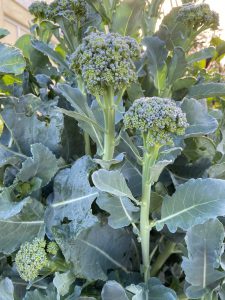
Artwork broccoli is a variety that produces small heads. Photo credit: Mary Salinas UF/IFAS Extension.
What vegetables are suitable for fall/winter gardening?
Cool Season Vegetables: https://gardeningsolutions.ifas.ufl.edu/plants/edibles/vegetables/cool-season-vegetables.html
North Florida Gardening Calendar: https://edis.ifas.ufl.edu/publication/EP451%20%20%20
Florida Vegetable Gardening Guide: https://edis.ifas.ufl.edu/publication/vh021
How can I add herbs to my landscape?
Herbs in the Florida Garden: https://gardeningsolutions.ifas.ufl.edu/plants/edibles/vegetables/herbs.html
My figs are green and hard. When do they ripen?
Why Won’t My Figs Ripen: https://www.lsuagcenter.com/profiles/rbogren/articles/page1597952870939
What is best soil for raised bed vegetable gardens?
Gardening in Raised Beds: https://edis.ifas.ufl.edu/publication/EP472
And there are always questions about weeds
How can I eradicate cogongrass?
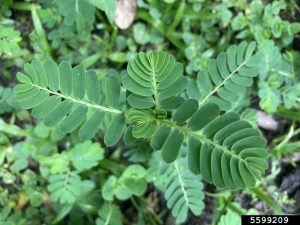
Chamber bitter is a troublesome warm season weed in our region. Photo credit: Brantlee Spakes Richter, University of Florida, Bugwood.org
Cogongrass: https://edis.ifas.ufl.edu/publication/WG202
Is it okay to use cardboard for weed control?
The Cardboard Controversy: https://gardenprofessors.com/the-cardboard-controversy/
What is the best way to control weeds in grass and landscape beds?
Weed Management Guide for Florida Lawns: https://edis.ifas.ufl.edu/publication/EP141
Improving Weed Control in Landscape Planting Beds: https://edis.ifas.ufl.edu/pdf/EP/EP52300.pdf
Landscape practices
Can ground water be brackish and stunt plants?
Reclaimed Water Use in the Landscape: https://edis.ifas.ufl.edu/publication/ss545
How can I prevent erosion from rainwater runoff?
Stormwater Runoff Control – NRCS: https://www.nrcs.usda.gov/wps/portal/nrcs/detail/national/water/?cid=nrcs144p2_027171
Rain Gardens: https://gardeningsolutions.ifas.ufl.edu/design/types-of-gardens/rain-gardens.html
And https://gardeningsolutions.ifas.ufl.edu/pdf/articles/rain-garden-manual-hillsborough.pdf
What is the best time of the year to propagate flowering trees in zone 8B?
Landscape Plant Propagation Information Page – UF/IFAS Env. Hort: https://hort.ifas.ufl.edu/database/lppi/
Which type of mulch works best on slopes greater than 3 percent?
Landscape Mulches: How Quickly do they Settle?: https://edis.ifas.ufl.edu/publication/FR052
When should bulbs be fertilized?
Bulbs and More – UI Extension: https://web.extension.illinois.edu/bulbs/planting.cfm
Should I cut the spent blooms of agapanthus?
Agapanthus, extending the bloom time: https://gardeningsolutions.ifas.ufl.edu/plants/ornamentals/agapanthus.html
http://blogs.ifas.ufl.edu/wakullaco/2020/10/07/extending-bloom-time/
Plant questions
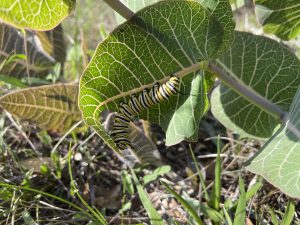
Monarch caterpillar munching on our native sandhill milkweed, Asclepias humistrata. Photo credit: Mary Salinas, UF IFAS Extension.
I planted native milkweed and have many monarch caterpillars. Should I protect them or leave them in nature?
It’s best to leave them in place. Featured Creatures: Monarch Butterfly: https://edis.ifas.ufl.edu/pdf/IN/IN780/IN780-Dxyup8sjiv.pdf
How does Vinca (periwinkle) do in direct sun? Will it make it through one of our panhandle summers? Can I plant in late August?
Periwinkles and No more fail with Cora series: https://gardeningsolutions.ifas.ufl.edu/plants/ornamentals/periwinkles.html#:~:text=Plant%20your%20periwinkles%20where%20they,rot%20if%20irrigated%20too%20frequently.
Insect and disease pests
What to do if you get termites in your raised bed?
The Facts About Termites and Mulch: https://edis.ifas.ufl.edu/publication/IN651
How to combat fungus?
Guidelines for ID and Management of Plant Disease Problems: https://edis.ifas.ufl.edu/publication/mg442
Are there preventative measures to prevent diseases when the humidity is very high and it is hot?
Fungi in Your Landscape by Maxine Hunter: http://blogs.ifas.ufl.edu/marionco/2020/01/16/fungi-in-your-landscape/
If you missed an episode, check out our playlist on YouTube https://www.youtube.com/watch?v=bp0HfdEkIQw&list=PLhgoAzWbtRXImdFE8Jdt0jsAOd-XldNCd
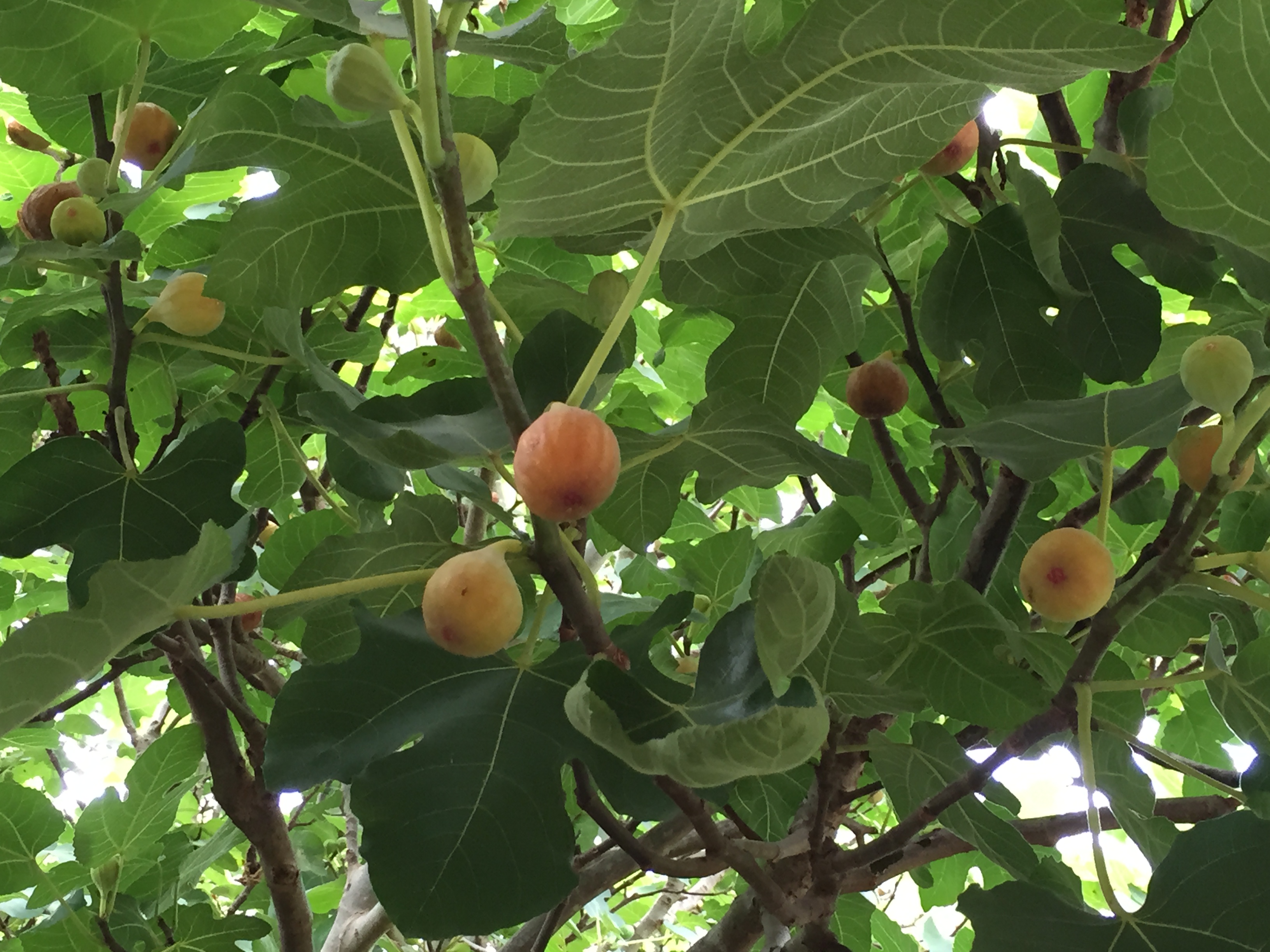
by Larry Williams | Jul 15, 2021
Q. One of my two fig trees has produced a few figs. The other one, which is the largest and healthiest tree, has never had a fig on it. Both where planted six years ago. Why is it not producing?
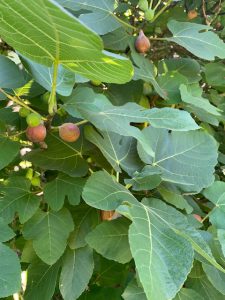
Mature fig tree with fruit. Photo credit: Larry Williams
A. It may be a matter of age and being overly vigorous. When a fruit tree is younger, it puts most of its energy into producing leaves and shoots. Until the plant becomes mature and slows down in the production of leaves and shoots, it will produce few to no fruit. It may take a year or two more for your tree to slowly and gradually switch from producing mostly leaves and shoots to producing and maturing some fruit. Patience is needed.
Be careful to not overdo it in fertilizing and/or pruning your fig tree. Too much fertilizer, especially nitrogen, or severely pruning the tree will result in the tree becoming overly vigorous at the expense of setting and maturing fruit. This includes fertilizer that the tree may pull up from a nearby lawn area. A tree’s roots will grow outward two to three times beyond its branch spread into adjacent lawn areas.
The end result of being heavy handed with fertilizing and/or overdoing it in pruning is the same – it forces the plant to become overly vigorous in producing leaves and shoots at the expense of producing and maturing fruit.
In addition, the following is taken from an Extension publication on figs and includes the most common reasons for lack of fruiting, in order of importance.
- Young, vigorous plants and over-fertilized plants will often produce fruit that drops off before maturing. If plants are excessively vigorous, stop fertilizing them. Quite often, three of four years may pass before the plant matures a crop because figs have a long juvenile period before producing edible quality fruit.
- Dry, hot periods that occur before ripening can cause poor fruit quality. If this is the case, mulching and supplemental watering during dry spells will reduce the problem.
- The variety Celeste will often drop fruit prematurely in hot weather regardless of the quality of plant care. However, it is still a good variety to grow.
- An infestation of root-knot nematodes can intensify the problem when conditions are as described in item 2.
- You could have a fig tree that requires cross-pollination by a special wasp. This is a rare problem. If this is the case, then it will never set a good crop. The best way to resolve this is to replace the plant with a rooted shoot of a neighbor’s plant you know produces a good crop each year.
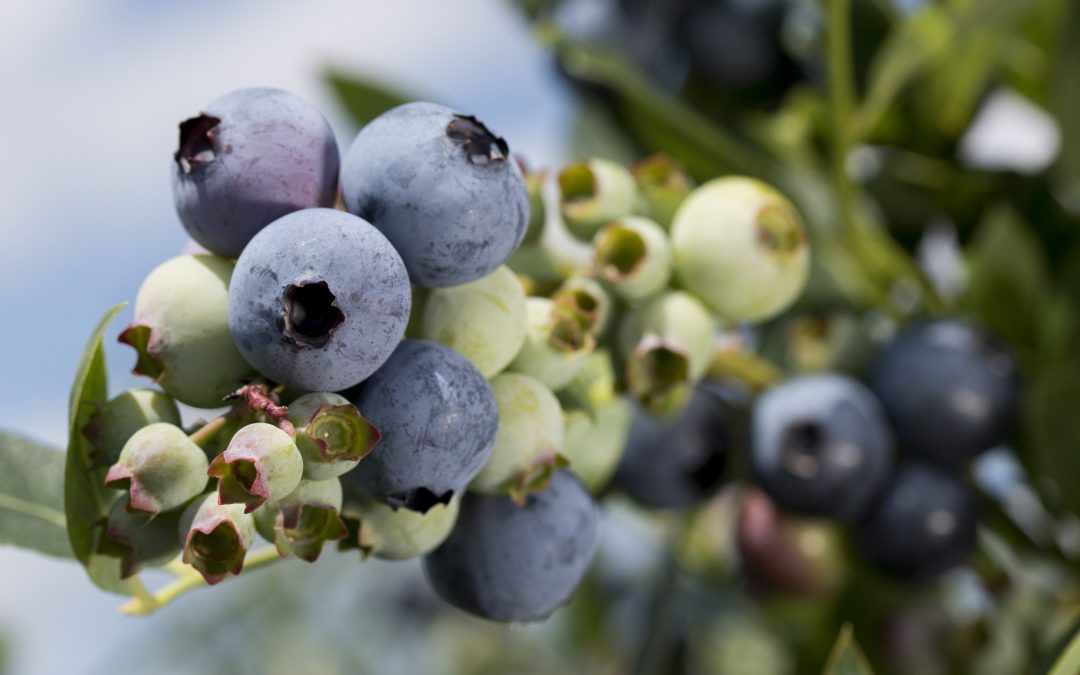
by Ray Bodrey | Jun 24, 2021
We have many choices of fruit that can be grown in the Florida Panhandle. For us hobby or dooryard growers, fruit trees can be an interesting crop to manage and most find it to be a beautiful addition to home landscapes. However, temperature and variety selection are key.
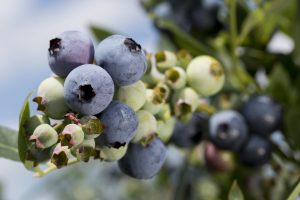
Blueberry Crop at UF/IFAS Plant Science Research & Education Unit. Photo Credit: Tyler Jones, UF/IFAS
Most fruit trees grown in the Panhandle are more temperate varieties, rather than tropical and subtropical fruits. Depending on the variety, winters in northern Florida may be too cold or may be too long for some fruit trees. Cold hardiness is a term used on fruit tree labels and reference guides. This refers to the plant’s ability to survive cooler or even freezing temperatures. In contrast, summer heat can also play a role in survivability. Some varieties are intolerant to excessive heat and humidity. The U.S. Department of Agriculture has developed a Plant Hardiness Zone Map that is helpful in selecting a variety of fruit tree: http://planthardiness.ars.usda.gov/PHZMWeb/. This is a standard by which gardeners and growers can determine which plants will thrive in their location. Northern Gulf County is in Zone 8b (15 to 20 degrees F), while coastal Gulf is in Zone 9a (20 to 25 degrees F).
Chilling requirement is another important topic when deciding on variety. Temperate zone fruit go through a “rest period” during the dormant months. For these fruit trees, a minimum length of time of cooler weather is needed for proper flowering to occur once favorable temperatures arrive. This rest period is essentially a reset. For the Panhandle, temperatures below 45 degrees F are known as chilling temperatures. The number of hours during the fall and winter that reach below this temperature equals the total chilling hours. For the Panhandle, this is rarely fewer than 500 hours. A plant that does not receive ample chilling will most likely be slow in bud and leaf development. Leaf expansion will be in increments throughout the year instead of in one period. On the other hand, colder, longer winters can cause fruit trees to end the rest stage early and begin to bud as soon as warmer temperatures arrive. This circumstance can cause cold injury later, as the Panhandle is historically known for late cold spells.
Citrus is a dooryard fruit, however it’s a subtropical fruit tree and not technically temperate. However, there are some varieties that thrive in the Panhandle. Another key to growing citrus, is to select varieties with different fruit maturity seasons. This way you can enjoy citrus year-round.
Some examples of dooryard fruit trees and varieties that are suitable for northern Florida are:
Apple: ‘TropicSweet’, ‘Anna’, ‘Dorsett Golden’
Blueberry: ‘Rabbiteye’, ‘Climax’, ‘Highbush’
Grapefruit: ‘Marsh’, ‘Ruby Red’
Lemon: ‘Myer’
Nectarine: ‘Suncoast’
Orange/Mandarin: ‘Navel’, ‘Parson Brown’, ‘Valencia’, Satsuma
Peach: ‘Gulfcrest’, ‘Gulfking’, ‘Gulfprince’
Pear: ‘Ayers’, ‘Baldwin’, ‘Kieffer’
Pecan: ‘Elliot’, ‘Stuart’, ‘Moreland’
So, where do I find information on varieties? The UF web publication “Dooryard Fruit Varieties” is a great resource. Also contact your local county extension office for more information.
Information for this article can be found in the UF/IFAS EDIS publication: “Dooryard Fruit Varieties” by J. G. Williamson, J. H. Crane, R. E. Rouse, and M. A. Olmstead: http://edis.ifas.ufl.edu/pdffiles/MG/MG24800.pdf
UF/IFAS Extension is an Equal Opportunity Institution.
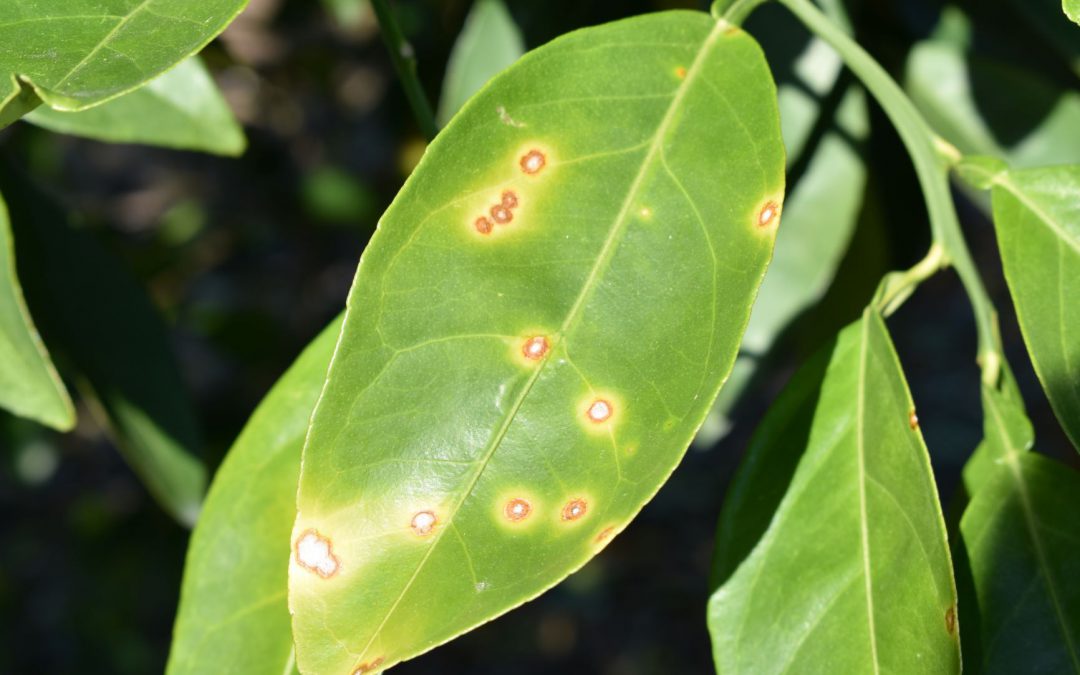
by Mary Salinas | Apr 1, 2021
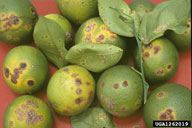
Citrus canker symptoms on twigs, leaves and fruit. Photo by Timothy Schubert, FDACS
Citrus canker was found for the first time in the Florida panhandle in Gulf Breeze in southern Santa Rosa County in November 2013. Since that time, citrus canker has spread widely in the Gulf Breeze area and just recently in 2020 was found in two locations in Panama City and Panama City Beach in Bay County.
Citrus canker is a serious bacterial disease that only infects citrus trees. It will not infect any other plant species nor is it a threat to human health. Severely affected trees experience substantial leaf loss and premature fruit drop and serve as a source for infecting nearby citrus. The disease spreads through wind, rain, and transportation of infected plant material from other locations.
This highly contagious disease has no cure although progression of the disease can be slowed through the use of copper-based products. This publication guides the homeowner on using copper.
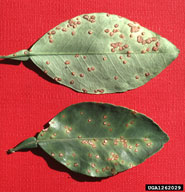
Citrus canker lesions on leaves are raised, rough and visible on both sides of the leaf. Photo by Timothy Shubert, FDACS.
Not all citrus varieties are equally susceptible to this disease. Grapefruit, lemon, and lime are some of the most vulnerable while tangerine and tangelo varieties are among the most resistant.
What should you do if you suspect your citrus is infected with this disease?
- Look at this guide for more information and compare the symptoms on your tree to the photos. Lesions on the leaves penetrate through the leaf so they are visible on the upper and lower leaf surfaces, are rough, and have a yellow halo. The lesions look similar on the fruit and stems. Lesions (or cankers) on the stems usually indicate a longer standing infection of a year or more.
- Consult your local Horticulture Extension Agent to confirm the diagnosis and obtain more information and control/removal strategies.
- Proper removal of infected trees is recommended to prevent the spread of citrus canker but is not mandatory. The best way to dispose of infected trees is through cutting them down and burning them onsite; this ensures than none of the plant material leaves your yard to infect other areas. Consult your local burn regulations before burning. Stray leaves, branches and fruit should be raked and burned or double bagged for the trash. Please avoid disposing of any of your citrus trees by putting them by the side of the road for pickup by the county yard waste recycling or regular waste disposal. The bacterium will survive in the plant tissue and be spread to other neighborhoods in the county. You can, however, double bag infected plant material in sturdy bags and place it in the trash.
For more information please see:
UF IFAS Gardening Solutions: Citrus
Citrus Culture in the Home Landscape
UF IFAS Extension Online Guide to Citrus Diseases
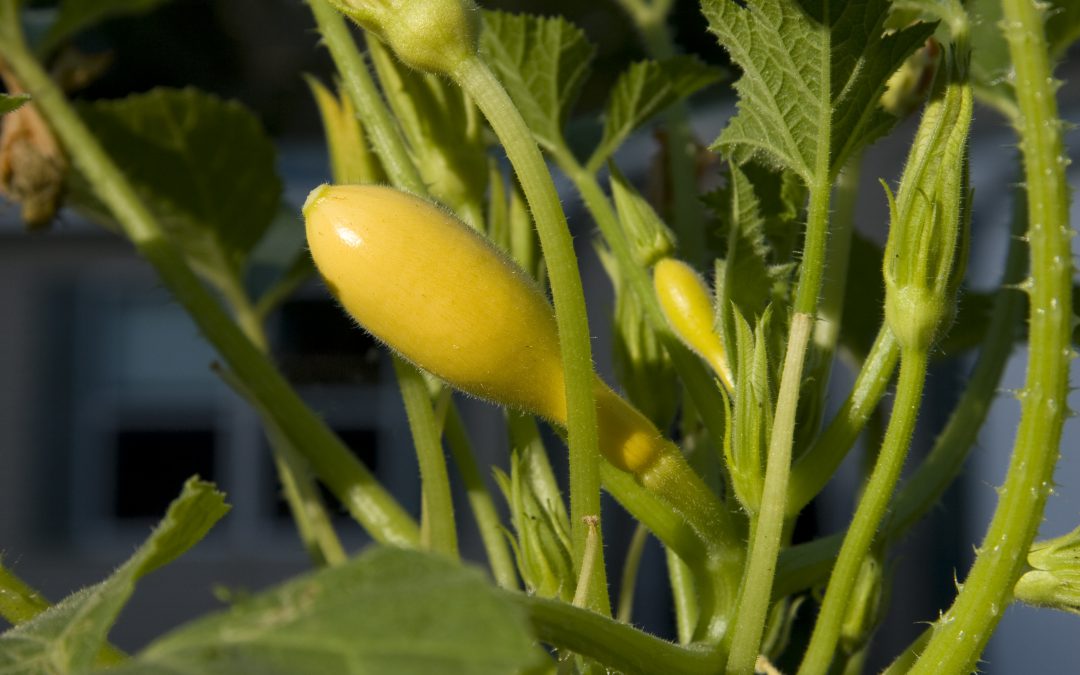
by Mary Salinas | Mar 18, 2021
The weather is warmer and plans and planting for spring vegetable gardens are in full swing. Last week many vegetable gardening topics were addressed in our Gardening in the Panhandle LIVE program. Here are all the links for all the topics we discussed. A recording of last week’s webinar can be found at: https://youtu.be/oJRM3g4lM78
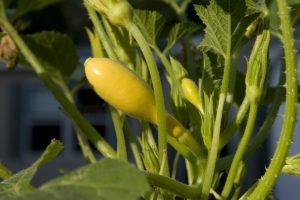
Home grown Squash. Gardening, vegetables. UF/IFAS Photo by Tom Wright.
Getting Started
The place to start is with UF’s ever popular and comprehensive Florida Vegetable Gardening Guide https://edis.ifas.ufl.edu/pdffiles/VH/VH02100.pdf
Many viewers expressed interest in natural methods of raising their crops. Take a look at Organic Vegetable Gardening in Florida https://edis.ifas.ufl.edu/pdffiles/HS/HS121500.pdf
The Square Foot Vegetable Planting Guide for Northwest Florida helps plan the layout of your garden https://sfyl.ifas.ufl.edu/media/sfylifasufledu/leon/docs/pdfs/Vegetable-Square-Foot-Planting-Guide-for-Northwest-Florida-mcj2020.pdf
Maybe you would like the convenience of starting with a fresh clean soil. Gardening in Raised Beds can assist you. https://edis.ifas.ufl.edu/ep472 Also see Gardening Solutions Raised Beds: Benefits and Maintenance https://gardeningsolutions.ifas.ufl.edu/design/types-of-gardens/raised-beds.html
Here is a guide to Fertilizing the Garden https://edis.ifas.ufl.edu/vh025
The Florida Panhandle Planting Guide will help you decide what to plant and when: https://www.facebook.com/SRCExtension/posts/4464210263604274
The Ever-Popular Tomato
To start your journey to the best tomatoes, start with UF/IFAS Gardening Solutions – Tomatoes https://gardeningsolutions.ifas.ufl.edu/plants/edibles/vegetables/tomatoes.html
If you are looking to grow in containers: https://sfyl.ifas.ufl.edu/media/sfylifasufledu/leon/docs/pdfs/Container-Gardening-Spacing-Varieties-UF-IFAS-mcj2020.pdf
Vegetable grafting is gaining in popularity, so if interested, look at this Techniques for Melon Grafting: https://edis.ifas.ufl.edu/hs1257
Blossom end rot occurs when irrigation is irregular and the calcium in the soil does not get carried to the developing fruit. The U-Scout program has a great description of this common problem: https://plantpath.ifas.ufl.edu/u-scout/tomato/blossom-end-rot.html
Our moderators talked about some of their favorite tomato varieties. Josh Freeman is partial to Amelia, a good slicing tomato. Matt Lollar shared some of the best tomato varieties for sauce: Plum/Roma types like BHN 685, Daytona, Mariana, Picus, Supremo and Tachi. For cherry tomatoes, Sheila Dunning recommended Sweet 100 and Juliette.
Whatever variety you choose, Josh says to pick when it starts changing color at the blossom end and bring it indoors to ripen away from pests.
Garden Pest Management
Let’s start with an underground pest. For those of you gardening in the native soil, very tiny roundworms can be a problem. Nematode Management in the Vegetable Garden can get you started: https://edis.ifas.ufl.edu/pdffiles/NG/NG00500.pdf
Leaffooted bugs are quite a nuisance going after the fruit. Here is how to control them: http://extension.msstate.edu/newsletters/bug%E2%80%99s-eye-view/2018/leaffooted-bugs-vol-4-no-24
Cutworms are another frustration. Learn about them here: https://nwdistrict.ifas.ufl.edu/hort/2020/02/27/cutworms-the-moonlit-garden-vandals/
Maybe your tomatoes have gotten eaten up by hornworms. https://gardeningsolutions.ifas.ufl.edu/care/pests-and-diseases/pests/hornworm-caterpillars.html
There are beneficial creatures helping to control the pest insects. Learn to recognize and conserve them and make for a healthier environment. Natural Enemies and Biological Control: https://edis.ifas.ufl.edu/pdffiles/IN/IN12000.pdf
If the beneficials are not numerous enough to control your pests, maybe a natural approach to pest control can help. Natural Products for Managing Landscape and Garden Pests in Florida: https://edis.ifas.ufl.edu/in197
Fungal and bacterial problems can also plague the garden. Go to Integrated Disease Management for Vegetable Crops in Florida for answers: https://edis.ifas.ufl.edu/pdffiles/PP/PP11100.pdf
Get control of weeds early and consult Controlling Weeds by Cultivating & Mulching https://hgic.clemson.edu/factsheet/controlling-weeds-by-cultivating-mulching/
Companion planting is a strategy that has been around for ages and for good reason: https://www.almanac.com/companion-planting-chart-vegetables Some good flowering additions to the garden that Sheila talked about are bee balm, calendula, marigold, nasturtiums, chives, and parsley.
And Some Miscellaneous Topics…
Peppers are another popular crop. Get some questions answered here: https://aggie-horticulture.tamu.edu/archives/parsons/vegetables/pepper.html
When can we plant spinach in Northeast Florida? http://blogs.ifas.ufl.edu/nassauco/2017/07/15/q-can-plant-spinach-northeast-florida/
Figs are a great fruit for northwest Florida. Get started here: https://edis.ifas.ufl.edu/pdffiles/MG/MG21400.pdf and with this https://aggie-horticulture.tamu.edu/extension/homefruit/fig/fig.html
















